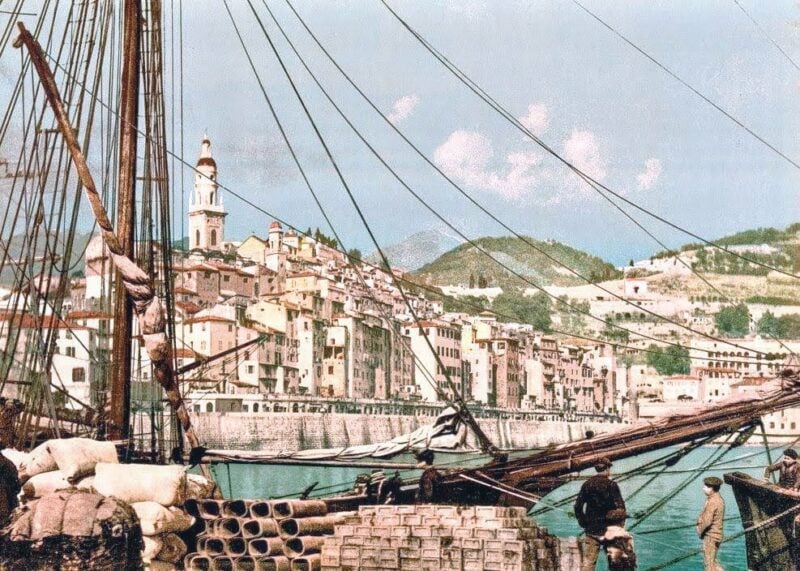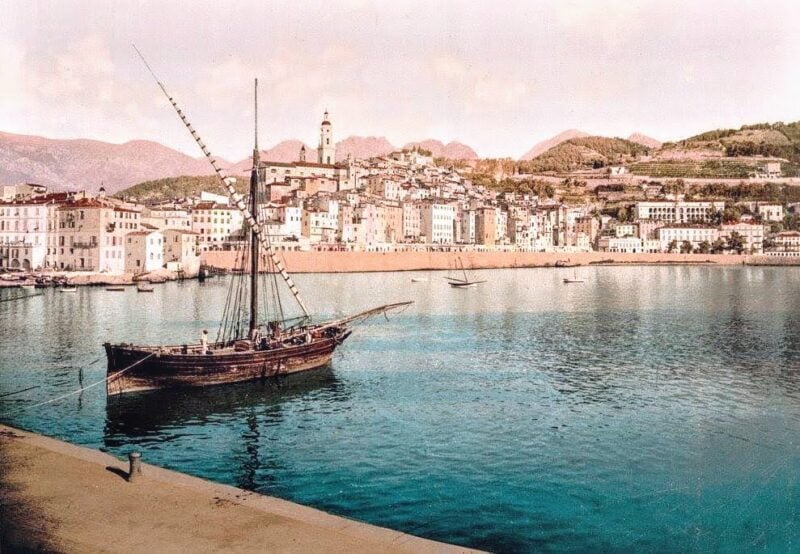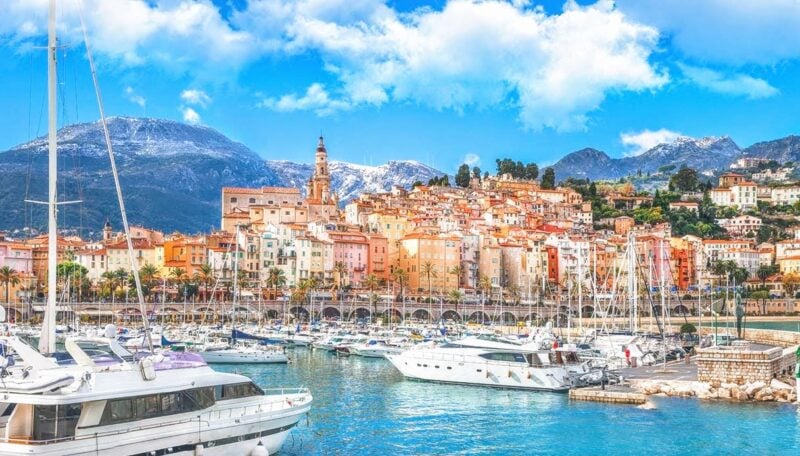Shortcuts
The Birth of the ‘French Riviera’
The highly-Instagrammable seaside town of Menton may well be lesser known than its Riviera neighbors, but it –along with Nice– was instrumental in establishing the French Riviera as possibly the oldest winter vacation spot in the world. Jean Cocteau painted his famous frescoes of love here, and English nobles planted exotic gardens around Italianate villas shaded by palm trees.
Tribes and Romans
Traces of occupation go back 3000 years or so, but until the end of the 18th century, the area later known as the Côte d’Azur was a remote and impoverished region, known mostly for fishing, olive groves, and flowers used in perfume. Tribal people now called “Ligurians” were the first known inhabitants of the French Riviera in historical times.
Not much is known of these aboriginals, only that they built fortified villages, notably on the site of modern Nice. Some centuries later, Greeks from overcrowded Phocaea moved, first into Massilia (Marseille), then outwards to Hyères and Nice, as they tended to do wherever there was a chance of industry or commerce.
The Greeks brought the vine (thoughtfully informing the earlier inhabitants what could be extracted from the wild stock indigenous to the area) as well as olives and other products of their advanced civilization. The Celts, who were at the same time putting down roots as far south as the Riviera, preferred the wilder hill country up from the coast — and to raid rather than trade.
The inhabitants of the land along this coastal strip had been accustomed to operating independently of “central” control. The Roman’s forced occupation –as commemorated by the trophy in La Turbie— was an important exception, but even then the numbers of occupiers was small and they had a specific task, to defend Roman access and trade routes, with little concern for the local inhabitants.
After the Roman retreat, and before the 18th century, the pockets of inhabited land were tiny compared with the wide swathes of rocky, scrubby hillsides and boggy river estuaries. Communities were isolated. Mosquitoes drove everyone mad, and getting around was dangerous and slow (little has changed).
Above all, it was a dull place, poor and uncultured, dilapidated and neglected by the outside world. It was waiting to be “rescued”. Divided between French and “Italian” spheres of influence, it was not a coherent society even within its contentious borders. Then came the British to transform the area and create the “French Riviera” as we know it…
How the British Transformed the French Riviera
In the 18th century, a taste for travel developed amongst the English aristocracy, especially spending the winter on the French Riviera. Viewed as a Garden of Eden, the South of France was also the natural ‘route’ to Italy and its culture, which was a fashionable place to experience, among the elites.

This seasonal migration of the English upper classes was quickly copied by other European elites, all in search of a mild winter. At the beginning of the 19th century, the health argument emerged – people would go to these winter resorts as a medical treatment.
The 18th century created the winter resort, and the 19th century sealed it.
The first British traveller to describe the area’s health benefits was the novelist Tobias Smollett, who visited Nice in 1763 when it was still an Italian city within the Kingdom of Sardinia. He brought Nice and its warm winter climate to the attention of the British aristocracy with ‘Travels through France and Italy (particularly Nice)‘, written in 1766. It’s a highly-amusing travel diary in the form of letters, in which he fell in love with Nice, foresaw the merits of Cannes (then a small village) as a health-resort, and envisioned the possibilities of the Corniche roads. Soon after it was published, sickly Brits started traveling to the French Riviera, thereby establishing it as the first winter resort area in the world.
Almost immediately, Scottish doctor John Brown picked up on this idea and became famous for prescribing what he called ‘climato-therapy’: a change in climate, to cure a variety of diseases. In 1780, he published his ‘Elements of Medicine‘, which for a time was an influential text. It set out his theories, often called the ‘Brunonian system of medicine’, which essentially understood all diseases as a matter of over or under-stimulation. The controversial and simplistic so-called ‘Brunonian theory’ dictated that all diseases fall into one of two categories: those caused by the absence of stimulus and those caused by too much stimulus. He and his contemporaries regarded the Mediterranean climate as offering a considerable variety of tonic and sedative environments.

Keeping the momentum going, British doctor John Bunnell Davis wrote his 1807 book, ‘The Ancient and Modern History of Nice‘. It became yet another voice which advocated for the French Riviera’s curative effect on disease. He wrote, “Who can for a moment doubt but that health is more likely to return when the path to its acquisition is strewn with flowers; when the painful burden that overwhelms the soul is alleviated by agreeable occupations, and when anxiety is exchanged for patience and resignation?”
This theory dominated European medical thought for roughly one century, until the late 1800’s, and the entire Mediterranean coast became something of a winter health resort for sufferers from all sorts of diseases (especially tuberculosis, which was killing one in six in England). Once Napoleon had been defeated in 1815 and peace prevailed on the continent, the British in particular began to flock to Nice, mostly for their health, and always in winter.
François-Joseph-Victor Broussais, a famous French physician, became very popular in the beginning of the 1820s; his medicinal theory was based on the Brunonian theory. French historian Paul Gonnet noted that doctors sent “to our shores a colony of pale and listless English women and listless sons of nobility near death”.

The French Riviera’s popularity further exploded when British doctor James Henry Bennet started promoting Menton’s climate as a health cure-all. Bennet had studied medicine in Paris, and after working as a doctor for 25 years, contracted what he self-diagnosed as tuberculosis (this was before they knew the cause was bacteria). In 1859, he claimed that he went to Menton to “…die in a quiet corner, like a wounded denizen of the forest” (but it’s more likely that he was familiar with the Brunonian theory and went to be cured). But instead, his health greatly improved, and he visited Italy the next year, but found the “unhygienic state of the large towns of that classical land undid the good previously obtained”. Unimpressed with Italy, he returned to Menton and started a medical practice.
When he was completely healed he returned to England to let his patients know about Menton. Word spread fast, as notable patients of Bennet’s included Robert Louis Stevenson and Queen Victoria. From then on, he spent every winter in Menton.
His 1861 book ‘Winter and Spring on the Shores of the Mediterranean‘ quickly boosted the popularity of Menton (then called ‘Mentone’) as a destination. Bennet felt that the hot and dry climate of the French Riviera as well as a proper diet cured tuberculosis sufferers. It was later translated into other languages and published in other countries, bringing everyone from Germans to Americans to Menton. Other doctors soon joined in the chorus.
While Lord Brougham had recently put Cannes on the map for carefully-selected members of London’s upper-crust society, readership of Bennet’s book was widespread and created an overwhelming influx of tourism. Many aristocrats, mostly with various health ailments, flocked to the French Riviera with the hope of getting cured. Without a doubt, more than one ‘consumption’ victim had asthma rather than tuberculosis, and getting away from the cold, damp and very smoggy British cities would have been all the ‘cure’ they needed.

In 1882, Queen Victoria took Bennet’s advice and came for an extended vacation, opening the floodgates for royals and high society to follow. She visited eight times after that and told her friends about how much she loved the area.
At the Queen’s suggestion, Winston Churchill chose to paint its’ landscapes, and many famous 19th century travel writers (such as Robert Louis Stevenson, Somerset Maugham, Scott Fitzgerald, Ernest Hemingway, H.G. Wells, Edith Wharton, Louisa May Alcott and Aldous Huxley) started writing about it.
Railways were built, grand villas replaced stone farmhouses, and ornate carriages carrying dukes and princes started showing up along high coast roads above the sparkling sea. Soon after, the French Riviera became famous in the USA as a high-end and glamorous vacation spot for celebrities and jet-setters.
Throughout the 20th century, Americans further transformed the French Riviera, with many of the most famous American authors and movie stars spending time or moving here. Superstar Grace Kelly married the Prince of Monaco, Rita Hayworth met and married a prince here, Sean Connery bought a villa in Nice and filmed scenes of ‘Never Say Never’ in the old town of Menton, and Americans with wealth or fame vacationed here.
Without the influence of wealthy Brits and Americans, the French Riviera would not be what it is today.
The French finally discovered the area as a vacation spot well after the English-speakers, and eventually started building smaller vacation homes and apartment blocks up and down the coast. Now, the French Riviera is a crowded mix of tourists, English-speaking expats, and French people.